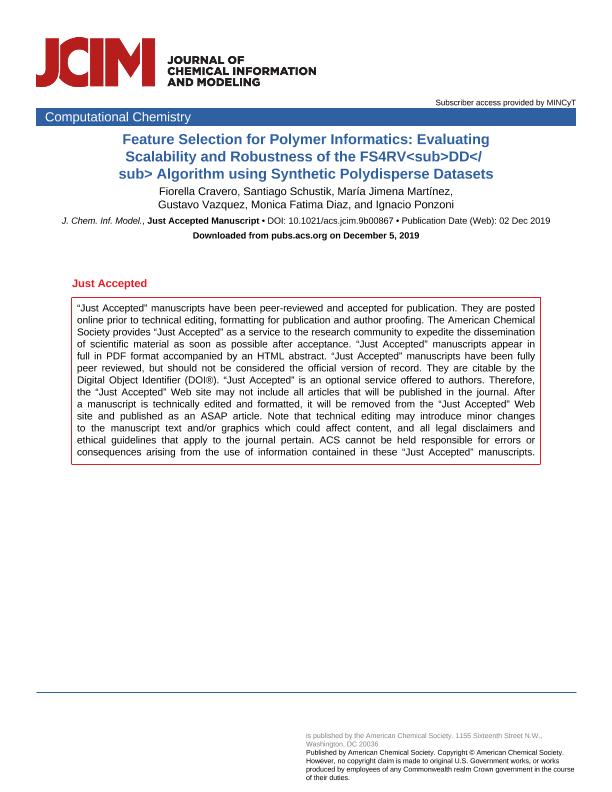Mostrar el registro sencillo del ítem
dc.contributor.author
Cravero, Fiorella

dc.contributor.author
Schustik, Santiago

dc.contributor.author
Martínez, María Jimena

dc.contributor.author
Vázquez, Gustavo

dc.contributor.author
Diaz, Monica Fatima

dc.contributor.author
Ponzoni, Ignacio

dc.date.available
2020-08-19T19:06:29Z
dc.date.issued
2020-02-24
dc.identifier.citation
Cravero, Fiorella; Schustik, Santiago; Martínez, María Jimena; Vázquez, Gustavo; Diaz, Monica Fatima; et al.; Feature Selection for Polymer Informatics: Evaluating Scalability and Robustness of the FS4RVDD Algorithm using Synthetic Polydisperse Datasets; American Chemical Society; Journal of Chemical Information and Modeling; 60; 2; 24-2-2020; 592-603
dc.identifier.issn
1549-9596
dc.identifier.uri
http://hdl.handle.net/11336/111958
dc.description.abstract
The feature selection (FS) process is a key step in the Quantitative Structure-Property Relationship (QSPR) modeling of physicochemical properties in Cheminformatics. In particular, the inference of QSPR models for polymeric material properties constitutes a complex problem because of the uncertainty introduced by the polydispersity of these materials. The main challenge is how to capture the polydispersity information from the molecular weight distribution (MWD) curve to achieve a more effective computational representation of polymeric materials. To date, most of the existing QSPR techniques use only a single molecule to represent each of these materials, but polydispersity is not considered. Consequently, QSPR models obtained by these approaches are being oversimplified. For this reason, we introduced in a previous work a new FS algorithm called Feature Selection for Random Variables with Discrete Distribution (FS4RVDD), which allows dealing with polydisperse data. In the present paper, we evaluate both the scalability and the robustness of the FS4RVDD algorithm. In this sense, we generated synthetic data by varying and combining different parameters: the size of the database, the cardinality of the selected feature subsets, the presence of noise in the data, and the type of correlation (linear and nonlinear). Moreover, the performances obtained by FS4RVDD were contrasted with traditional FS techniques applied to different simplified representations of polymeric materials. The obtained results show that the FS4RVDD algorithm outperformed the traditional FS methods in all proposed scenarios, which suggest the need of an algorithm such as FS4RVDD to deal with the uncertainty that polydispersity introduces in human-made polymers.
dc.format
application/pdf
dc.language.iso
eng
dc.publisher
American Chemical Society

dc.rights
info:eu-repo/semantics/embargoedAccess
dc.rights.uri
https://creativecommons.org/licenses/by-nc/2.5/ar/
dc.subject
ALGORITHMS
dc.subject
MACHINE LEARNING
dc.subject
PHYSICAL AND CHEMICAL PROPERTIES
dc.subject
POLYMERS
dc.subject.classification
Compuestos

dc.subject.classification
Ingeniería de los Materiales

dc.subject.classification
INGENIERÍAS Y TECNOLOGÍAS

dc.subject.classification
Otras Ciencias de la Computación e Información

dc.subject.classification
Ciencias de la Computación e Información

dc.subject.classification
CIENCIAS NATURALES Y EXACTAS

dc.title
Feature Selection for Polymer Informatics: Evaluating Scalability and Robustness of the FS4RVDD Algorithm using Synthetic Polydisperse Datasets
dc.type
info:eu-repo/semantics/article
dc.type
info:ar-repo/semantics/artículo
dc.type
info:eu-repo/semantics/publishedVersion
dc.date.updated
2020-04-23T21:23:43Z
dc.journal.volume
60
dc.journal.number
2
dc.journal.pagination
592-603
dc.journal.pais
Estados Unidos

dc.journal.ciudad
Washington DC
dc.description.fil
Fil: Cravero, Fiorella. Consejo Nacional de Investigaciones Científicas y Técnicas. Centro Científico Tecnológico Conicet - Bahía Blanca. Planta Piloto de Ingeniería Química. Universidad Nacional del Sur. Planta Piloto de Ingeniería Química; Argentina
dc.description.fil
Fil: Schustik, Santiago. Consejo Nacional de Investigaciones Científicas y Técnicas. Centro Científico Tecnológico Conicet - Bahía Blanca. Planta Piloto de Ingeniería Química. Universidad Nacional del Sur. Planta Piloto de Ingeniería Química; Argentina. Provincia de Buenos Aires. Gobernación. Comisión de Investigaciones Científicas; Argentina
dc.description.fil
Fil: Martínez, María Jimena. Consejo Nacional de Investigaciones Científicas y Técnicas. Centro Científico Tecnológico Conicet - Bahía Blanca. Instituto de Ciencias e Ingeniería de la Computación. Universidad Nacional del Sur. Departamento de Ciencias e Ingeniería de la Computación. Instituto de Ciencias e Ingeniería de la Computación; Argentina
dc.description.fil
Fil: Vázquez, Gustavo. Universidad Católica del Uruguay; Uruguay
dc.description.fil
Fil: Diaz, Monica Fatima. Consejo Nacional de Investigaciones Científicas y Técnicas. Centro Científico Tecnológico Conicet - Bahía Blanca. Planta Piloto de Ingeniería Química. Universidad Nacional del Sur. Planta Piloto de Ingeniería Química; Argentina. Universidad Nacional del Sur. Departamento de Ingeniería Química; Argentina
dc.description.fil
Fil: Ponzoni, Ignacio. Consejo Nacional de Investigaciones Científicas y Técnicas. Centro Científico Tecnológico Conicet - Bahía Blanca. Instituto de Ciencias e Ingeniería de la Computación. Universidad Nacional del Sur. Departamento de Ciencias e Ingeniería de la Computación. Instituto de Ciencias e Ingeniería de la Computación; Argentina. Universidad Nacional del Sur. Departamento de Ciencias e Ingeniería de la Computación; Argentina
dc.journal.title
Journal of Chemical Information and Modeling

dc.rights.embargoDate
2020-08-25
dc.relation.alternativeid
info:eu-repo/semantics/altIdentifier/url/https://pubs.acs.org/doi/abs/10.1021/acs.jcim.9b00867
dc.relation.alternativeid
info:eu-repo/semantics/altIdentifier/doi/http://dx.doi.org/10.1021/acs.jcim.9b00867
Archivos asociados
